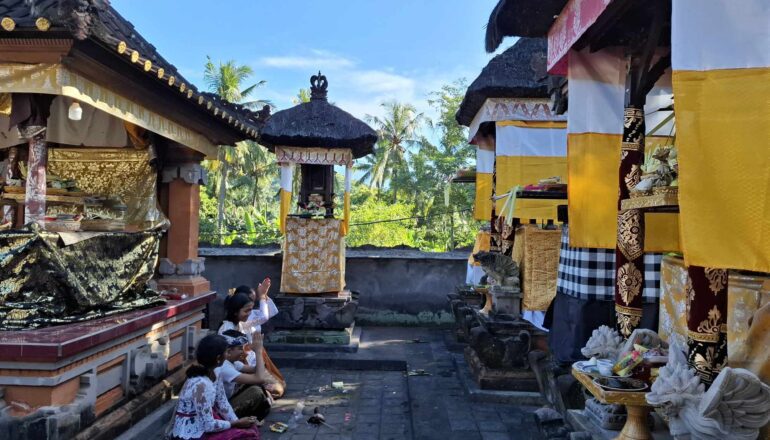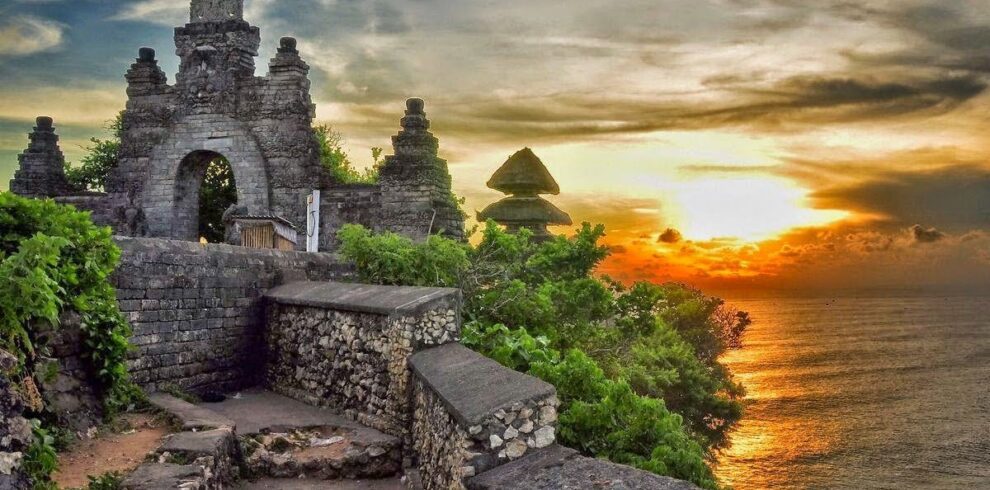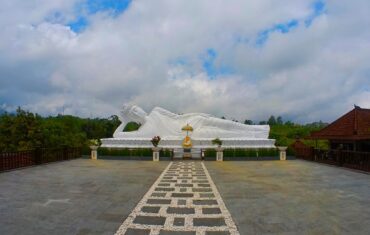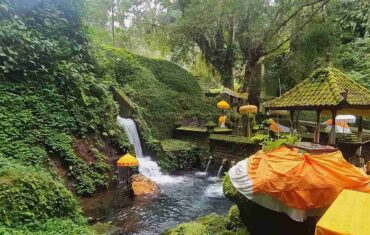Bali, the famed Island of the Gods, is renowned for its rich cultural heritage, stunning landscapes, and deeply spiritual ceremonies. Among its many important religious events, Galungan ceremony stands out as one of the most significant and vibrant Hindu festivals on the island. For travelers and culture enthusiasts, experiencing Galungan is an opportunity to witness Bali at its most spiritually profound and culturally rich.
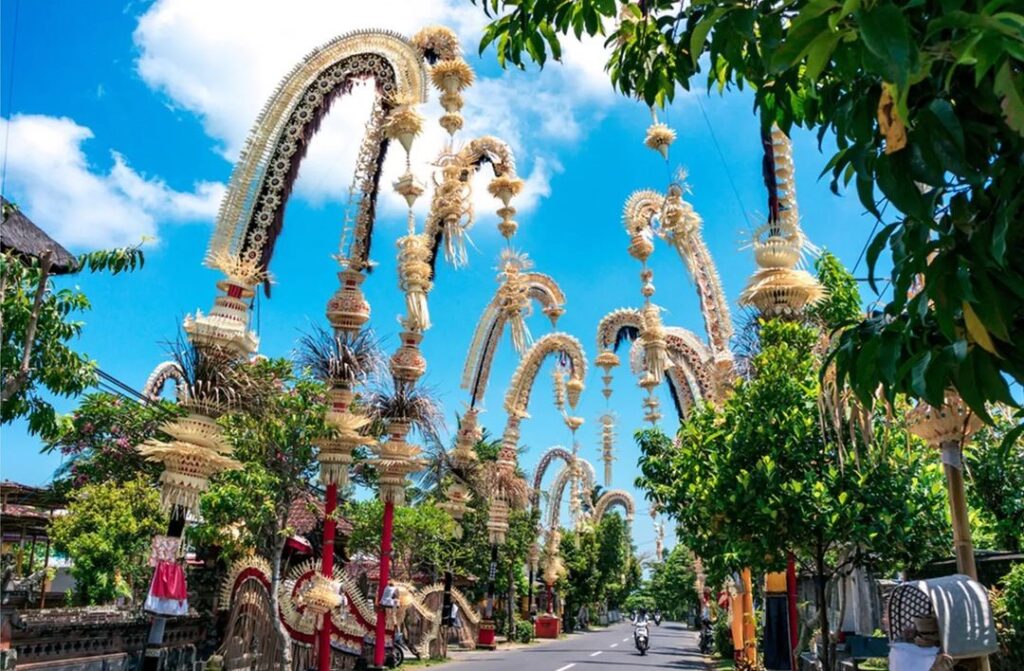
Galungan is a celebration of the victory of dharma (good) over adharma (evil). This festival symbolizes the triumph of righteousness and serves as a reminder to Balinese Hindus of their spiritual obligations. During Galungan, Balinese families welcome ancestral spirits back to earth, offering them prayers, food, and hospitality.
In this guide, you will discover everything you need to know about the Galungan Ceremony. From its history and symbolism to rituals, traditions, and modern-day significance, this comprehensive post will take you deep into the heart of Balinese culture.
Read Here: Canang Sari: The Sacred Offering of Daily Life in Bali
1. The Meaning and Symbolism of Galungan
What Does Galungan Mean?
The word “Galungan” is derived from the ancient Balinese language, meaning “to win” or “victory.” The festival commemorates the triumph of Dharma, or virtuous living, over Adharma, the forces of chaos and evil. For Balinese Hindus, this is a spiritual metaphor that represents the human struggle between good and evil tendencies.

Symbolic Elements of Galungan
Throughout Bali, during Galungan, you will notice penjor—beautifully decorated bamboo poles with offerings at their tips—lining the streets. These penjors symbolize prosperity, the dominance of dharma, and gratitude to the gods. They are a visual representation of Mount Agung, the sacred mountain of Bali, believed to be the abode of ancestral spirits and deities.
Furthermore, the ancestral spirits, known as Dewa Pitara, return to visit their living descendants during Galungan. Families make special offerings to welcome and honor these spirits.
2. The Origins and History of Galungan Ceremony
Ancient Beginnings
The Galungan ceremony has ancient roots in Bali’s Hindu traditions. It is believed to have originated centuries ago, influenced by Hindu Dharma brought to Bali from India. The specific origin story links back to Balinese mythology where the gods fought a great battle against demonic forces. When they were victorious, Galungan was established as a celebration of their triumph.
Mythological Story of Galungan
One widely shared myth tells of Mayadenawa, a powerful but tyrannical king who banned worship of the gods. The gods sent Indra, the king of the gods, to defeat Mayadenawa and restore balance to Bali. The day of Indra’s victory is celebrated as Galungan, while Kuningan, which follows 10 days later, marks the gods’ return to heaven.
3. When and How Often is Galungan Celebrated?
The Balinese Pawukon Calendar
Galungan follows the 210-day Balinese Pawukon calendar, so it occurs twice a year. This unique calendar cycles faster than the Gregorian calendar, which is why Galungan does not fall on the same date every year according to Western reckoning.
Galungan and Kuningan Dates
Galungan always takes place on Wednesday, or Buda Kliwon Dungulan, while Kuningan falls on Saturday, or Saniscara Kliwon Kuningan, ten days later. These dates are highly auspicious and mark the beginning and end of the Galungan period.
4. The Spiritual Significance of Galungan for the Balinese People
Victory of Good Over Evil
For Balinese Hindus, Galungan is not just a celebration but also a time for reflection. It is a reminder to always uphold truth, justice, and virtue in their daily lives.
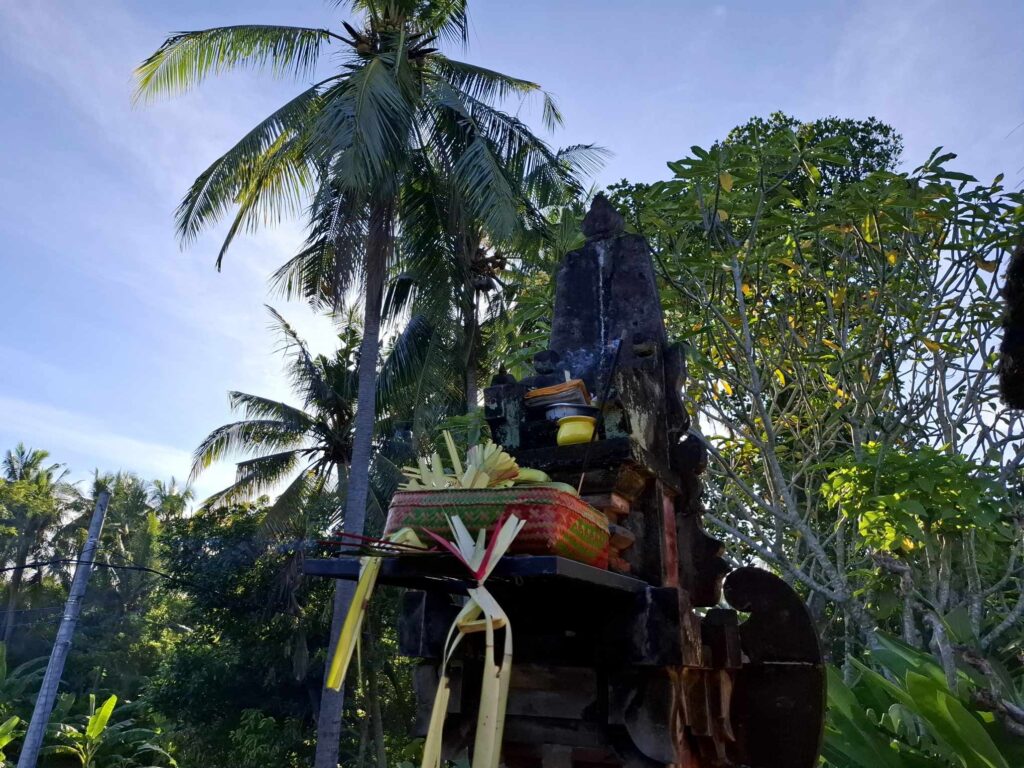
Honoring Ancestors and Deities
The primary purpose of Galungan is to honor ancestral spirits and gods. Balinese believe that during Galungan, their ancestors descend to earth. Families invite them into their homes by offering prayers, food, and hospitality at their family shrines.
Community and Family Bonding
Galungan also reinforces social and familial bonds. Families reunite, and community members come together to celebrate, pray, and share meals. It’s a time of spiritual and cultural pride.
5. Rituals and Traditions During the Galungan Ceremony
Preparations Before Galungan
Preparations for Galungan begin several days in advance. Each day has its own rituals and significance:
- Sugihan Jawa (6 days before): Cleansing of the self, both physically and spiritually.
- Sugihan Bali (5 days before): Cleansing the environment, temples, and family shrines.
- Penyekeban (3 days before): Families begin cooking and preparing traditional foods, including bananas which must ripen in time for offerings.
- Penyajahan (2 days before): Women prepare cakes and traditional snacks such as jaja uli and jaja ketan for the ceremonial offerings.
- Penampahan (1 day before): Sacrificial offerings, usually a pig or chicken, are made. Families also install the penjor outside their homes.
The Day of Galungan
On Galungan Day itself, Balinese Hindus wake early to pray at family temples and village temples. They wear traditional ceremonial attire and bring offerings to honor their ancestors and deities.

Men visit their patrilineal family temples, while women stay home to tend to the family’s ancestral altars. After prayers, families share meals and celebrate with music, dance, and storytelling.
Penjor: The Bamboo Poles of Galungan
The penjor are perhaps the most recognizable symbol of Galungan. These tall, curved bamboo poles are decorated with coconut leaves, rice, fruits, cakes, and even money. Each element symbolizes prosperity and devotion. The curved shape represents Mount Agung, believed to be the axis of the universe.
Barong and Rangda: The Sacred Dances
During Galungan, sacred Barong and Rangda dances are performed in villages. The Barong, a mythical lion-like creature, symbolizes goodness, while Rangda, a frightening witch figure, represents evil. The dance is a visual storytelling of the eternal struggle between good and evil, reinforcing the spiritual themes of Galungan.
6. Kuningan Day: The Culmination of Galungan
What is Kuningan?
Kuningan marks the end of Galungan, occurring ten days after. It is believed that the ancestral spirits and deities return to heaven on this day. Special offerings made with yellow rice (nasi kuning) symbolize prosperity and gratitude.
Rituals on Kuningan
Families visit temples and pray for continued blessings. Small offerings called tamiang, made from woven palm leaves and representing protection, are hung at shrines and homes. Kuningan is a joyful celebration where families give thanks and seek protection until the next Galungan cycle.
7. Foods and Offerings During Galungan and Kuningan
Traditional Dishes
Galungan is a time for feasting. Special dishes include:
- Lawar: A mixture of vegetables, coconut, and minced meat.
- Satay: Skewered grilled meat, often made from pork or chicken.
- Nasi Kuning: Yellow rice cooked with turmeric and coconut milk.
- Babi Guling: Balinese-style roasted pig, commonly served during feasts.
Types of Offerings (Banten)
Balinese make elaborate offerings during Galungan, known as banten. They include fruits, flowers, rice cakes, and meat. Each offering is carefully arranged in woven palm-leaf baskets, demonstrating artistry and devotion.
8. The Atmosphere During Galungan in Bali
Spiritual Energy
The spiritual energy in Bali during Galungan is palpable. The streets are lined with penjors, and temples are adorned with colorful decorations. The air is filled with the scent of incense, and you’ll hear the sound of gamelan music accompanying processions and temple ceremonies.
Community Celebrations
Villages come alive with cultural performances, traditional dances, and communal meals. Balinese people dress in their finest ceremonial attire, adding to the festival’s vibrant atmosphere.
9. Experiencing Galungan as a Visitor
Respecting Local Customs
Visitors are welcome to observe Galungan celebrations but should be respectful. Wear appropriate temple attire, including sarongs and sashes, when visiting temples.

Best Places to Experience Galungan
Some of the best places to experience Galungan include:
- Ubud: Known for its rich culture and temple ceremonies.
- Besakih Temple: Bali’s mother temple hosts grand Galungan celebrations.
- Denpasar and Villages: Where authentic, family-centered celebrations take place.
Participate in Offerings and Temple Visits
Some Balinese families offer cultural immersion programs during Galungan. As a guest, you may help prepare offerings, join in prayers, or witness traditional dances and ceremonies.
10. Modern-Day Relevance of Galungan
Preserving Tradition in a Modern World
Despite modern influences, Galungan remains deeply significant to Balinese society. Young generations are taught the importance of tradition, ensuring that the cultural heritage of Galungan endures.
Tourism and Cultural Exchange
Galungan attracts visitors from around the world, promoting cultural understanding and respect. Tourists leave Bali with a deeper appreciation for its spiritual life and traditions.
11. Key Takeaways About Galungan
- Galungan celebrates the victory of good over evil.
- It is a family-centered and community-based festival.
- Ancestral spirits are honored, and gods are worshipped.
- Penjor and Barong dances are iconic symbols of Galungan.
- Visitors are welcome but should be respectful of traditions.
Conclusion: Galungan – The Heart of Balinese Spiritual Life
Galungan is more than a festival. It’s the soul of Balinese Hinduism, where families reunite, spirits are honored, and virtues are reaffirmed. Whether you are a local or a visitor, experiencing Galungan offers a rare glimpse into Bali’s spiritual heart. The island comes alive with color, music, devotion, and joy, reminding everyone of the eternal victory of goodness over darkness.
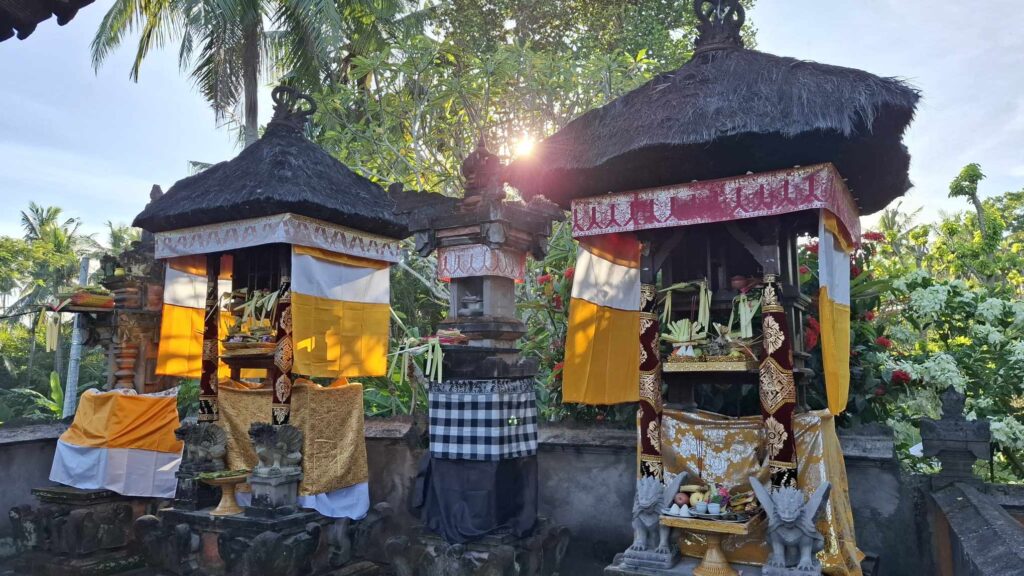
If you ever plan your visit to Bali, timing it during Galungan will enrich your journey. You will return home not just with photographs but with memories of a sacred celebration and a deeper understanding of Balinese culture.
Read Here: Aling-Aling Waterfall: A Complete Guide to Bali’s Hidden Gem
The Best Trip Destination
Bali, Indonesia, beckons with its diverse allure. Explore Ubud’s cultural treasures, witness the iconic Tanah Lot Temple at sunset, and surf the waves of Kuta Beach. Discover the scenic beauty of Tegallalang Rice Terraces and embrace the lively atmosphere of Seminyak. Dive into the underwater wonders of Amed, relax on the pristine shores of Nusa Dua, and wander through ancient temples in the heart of Bali. Whether seeking vibrant nightlife, serene landscapes, or cultural richness, Bali’s enchanting destinations cater to every traveler’s desire.
Ubud (14 Trips)
Eastern Bali (7 Trips)
Southern Bali (5 Trips)
Northern Bali (5 Trips)
Nusa Penida Island (4 Trips)
Western Bali (4 Trips)
The Best Activities In Bali
Indulge in Bali’s diverse activities, from surfing the waves in Kuta to exploring cultural treasures in Ubud. Snorkel vibrant coral reefs in Amed, trek lush rice terraces, and rejuvenate in serene spa retreats. Dive into the lively nightlife of Seminyak, witness traditional dance performances, and sample local delicacies in bustling markets. Whether it’s hiking Mount Batur for a sunrise vista or embracing the spiritual ambiance of ancient temples, Bali offers a kaleidoscope of experiences for every traveler’s passion.

